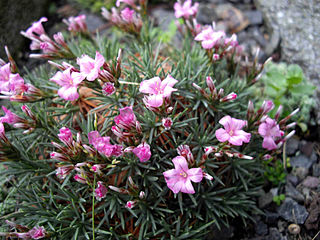
Plumbaginaceae is a family of flowering plants, with a cosmopolitan distribution. The family is sometimes referred to as the leadwort family or the plumbago family.
Acantholimon koeycegizicum, is a species of plant belonging to the family Plumbaginaceae.
Acantholimon goeksunicum is a species of plant belonging to the family Plumbaginaceae. It is only found on calcareous steppes in southeastern Anatolia (Turkey).
Iris heweri is a plant species in the genus Iris, it is also in the subgenus Iris and in the section Regelia. It is a rhizomatous perennial, from Afghanistan. It has tall, green curved leaves, tall slender stems and purple blue or violet-blue flowers, with white and purple or lilac beard. It is cultivated as an ornamental plant in temperate regions.

Acantholimon libanoticum(Lebanese prickly thrift, غملول لبناني) is a plant in the family Plumbaginaceae first described by Pierre Edmond Boissier. It is native to Western Asia from Turkey to Syria and Lebanon.
Acantholimon gillii is a species of plant described by Karl Heinz Rechinger and Mogens Engell Köie. Acantholimon gillii is part of the genus Acantholimon and the family Plumbaginaceae.

Acantholimon acerosum is a species of plant in the Plumbaginaceae family that is native from Turkey to Northwest Iran. The species are evergreen and sprout flowers June. Acantholimon acerosum grows in light well drained soil that is gritty and limey.

Acantholimon ulicinum, also known as the prickly thief, is a species of broadleaf evergreen plants in the family Plumbaginaceae. Acantholimon ulicinum is around 10 cm (4 in) tall and has a spread of 30 cm (1 ft). The species is endemic to the eastern Mediterranean region where it grows in dry soil. From June to July is when Acantholimon ulicinum blooms, with pale pink flowers. It has crowded, rigid, hard-textured, spiny-tipped, linear and needle-like leaves, and five-petaled pink flowers in short-stalked inflorescences.
Acantholimon trojanum, also known as prickly thrift, is a species of perennial plant. It is native to Turkey and can survive in hardiness zones 5a to 9b. The species typically reaches a height of around 1.2 meters (4 ft). Acantholimon trojanum grows in rocky soil and has a foliage colour of green and blue with flowers being pink, and blooms in the summer. The leaves are food items for deer and rabbit species.
Acantholimon afanassievii is a species of flowering plant in the Plumbaginaceae family. The native range of this species is in Central Asia and it was discovered by Lincz.
Acantholimon tataricum is a species of flowering plant in the family Plumbaginaceae. The native range of this species is in Xinjiang and the Western Himalayas and it was discovered by Boiss.
Acantholimon collare is a species of flowering plant in the Plumbaginaceae family described by Mogens Engell Köie and Karl Heinz Rechinger. The native range of this species is North East Iran. A phytochemical analysis from the University of Birjand found that the antimicrobial nature of compounds found in A. collare make it potentially suitable for pharmaceutical use.
Acantholimon schemachense is a species of flowering plant in the Plumbaginaceae family. The native range of this species is in the North Caucasus and the Transcaucasus, and it was described by Gross in 1931.
Acantholimon riyatguelii is a species of flowering plant in the family Plumbaginaceae. The native range of this species is in Turkey and Iran. It was first described by Hasan Yıldırım in 2014.
Acantholimon alberti is a species of flowering plant in the family Plumbaginaceae. The native range of this species is Central Asia, it is a subshrub and grows primarily in the temperate biome and was described by Regel.
Acantholimon venustum is a species of flowering plant in the family Plumbaginaceae. The native range of this species is from Turkey to Iran and West Syria, it is a subshrub and grows primarily in the temperate biome and was described by Boiss. The plant is a broadleaf evergreen perennial with blue foliage, In the spring, white flowers emerge. The plant is also known as prickly thrift.

Acantholimon zakirovii is a species of flowering plant in the family Plumbaginaceae. The native range of this species is Uzbekistan. It is a subshrub and grows primarily in the subalpine or subarctic biome and was described by Beshko.
Acantholimon chitralicum is a species of flowering plant in the family Plumbaginaceae. The native range of this species is Afghanistan. It is a subshrub and grows primarily in the temperate biome.
Acantholimon distichum is a species of flowering plant within the family Plumbaginaceae. This species is endemic to Sangcharak, Afghanistan. It is a short woody plant that grows primarily in the temperate biome.
Acantholimon ekbergianum is a species of flowering plant in the family Plumbaginaceae. The native range of this species is Afghanistan (Bamyan). It is a subshrub and grows primarily in the temperate biome.






